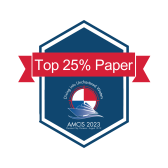Loading...
Paper Type
Complete
Description
Enterprise Resource Planning (ERP) systems are critical to the success of enterprises, facilitating business operations through standardized digital processes. However, existing ERP systems are unsuitable for startups and small and medium-sized enterprises that grow quickly and require adaptable solutions with low barriers to entry. Drawing upon 15 explorative interviews with industry experts, we examine the challenges of current ERP systems using the task technology fit theory across companies of varying sizes. We describe high entry barriers, high costs of implementing implicit processes, and insufficient interoperability of already employed tools. We present a vision of a future business process platform based on three enablers: Business processes as first-class entities, semantic data and processes, and cloud-native elasticity and high availability. We discuss how these enablers address current ERP systems’ challenges and how they may be used for research on the next generation of business software for tomorrow’s enterprises.
Paper Number
1348
Recommended Citation
Böhme, Lukas; Wuttke, Tobias; Bender, Benedict; Teusner, Ralf; Baltes, Sebastian; Matthies, Christoph; and Perscheid, Michael, "From Full-fledged ERP Systems Towards Process-centric Business Process Platforms" (2023). AMCIS 2023 Proceedings. 1.
https://aisel.aisnet.org/amcis2023/enter_syst/enter_syst/1
From Full-fledged ERP Systems Towards Process-centric Business Process Platforms
Enterprise Resource Planning (ERP) systems are critical to the success of enterprises, facilitating business operations through standardized digital processes. However, existing ERP systems are unsuitable for startups and small and medium-sized enterprises that grow quickly and require adaptable solutions with low barriers to entry. Drawing upon 15 explorative interviews with industry experts, we examine the challenges of current ERP systems using the task technology fit theory across companies of varying sizes. We describe high entry barriers, high costs of implementing implicit processes, and insufficient interoperability of already employed tools. We present a vision of a future business process platform based on three enablers: Business processes as first-class entities, semantic data and processes, and cloud-native elasticity and high availability. We discuss how these enablers address current ERP systems’ challenges and how they may be used for research on the next generation of business software for tomorrow’s enterprises.
When commenting on articles, please be friendly, welcoming, respectful and abide by the AIS eLibrary Discussion Thread Code of Conduct posted here.




Comments
SIG EntSys